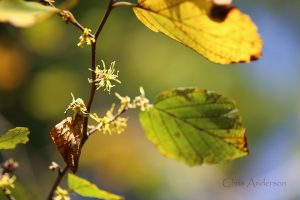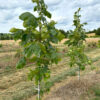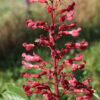With spidery yellow petals and a delicate citrus scent, the witch hazel (Hamamelis virginiana) flower is unique among shrubs of eastern forests; delicate tentacles extend outwards from the twigs, often overlooked by the foliage on the branches in the fall. Several hybrid witch hazels bloom in the spring, but our native is a late autumn-blooming beauty.
They generally grow 10-25 feet tall as twisted shrub or small tree, frequently tucked under the canopy of other moist, upland eastern hardwood trees. Seeds can shoot up to 20 feet from ripe pods and they often form clumps. Once established, they tend to be pest and disease free and do not require much, if any, care. For full flowering, they require moisture in the summer and a period of winter cold. They are unique in North America as they are the only tree with fruit, flowers and next year’s buds on the plant simultaneously.
 In addition to its attractiveness in the landscape, the medicinal properties of witch hazel are well known by many Indigenous cultures across North America as the shrubs grow from Nova Scotia to Georgia and west to Minnesota and Missouri. Native American Indians were (and are) the first doctors and botanists in North America, understanding the healing properties of native trees, shrubs, and plants and the specific seasons in which they should be harvested.
In addition to its attractiveness in the landscape, the medicinal properties of witch hazel are well known by many Indigenous cultures across North America as the shrubs grow from Nova Scotia to Georgia and west to Minnesota and Missouri. Native American Indians were (and are) the first doctors and botanists in North America, understanding the healing properties of native trees, shrubs, and plants and the specific seasons in which they should be harvested.
Drugstores carry commercial extracts today. Dried leaves, bark and twigs are used as an astringent and for treating a variety of maladies including tumors, eye infection, burns and hemorrhoids. The mechanism of witch hazel astringency involves tightening of skin proteins which draw together, forming a protective covering and promoting healing.1
Witch hazel is one of the most common home botanical remedies in the US today, perhaps even surpassing aloe. It is sometimes applied with a steam towel to bruises and strains or in a cold compress to treat fevers.2
They are related to sweet gum and the common name refers to their use in divining or “witching” water.
American Forests lists a Russel County, Virginia witch hazel nominated in 2017 as the current national champion.
For survivalists and “preppers” and those interested in continuing Indigenous knowledge, witch hazel is a good plant to know and grow.
For landscapers, witch hazel offers solid structure throughout the summer and can be planted as a specimen shrub or small tree, border or mixed hedge. They add late season interest, particularly when planted in locations where their sweet flowers can be enjoyed.
Chris Anderson, Executive Director
White House Farm Foundation
1917 Kauffmans Mill Road
Luray, VA 22835







